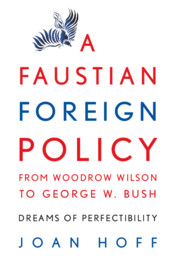Book contents
- Frontmatter
- Contents
- Introduction: Toward a Faustian Diplomacy
- 1 The United States Forms and Refines Its Diplomacy
- 2 The Faustian Impact of World War I on U.S. Diplomacy
- 3 The Faustian Aspects of Prosperity, Depression, and War
- 4 Faustian Aspects of U.S. Cold War Foreign Policy
- 5 Cold War Transformation of the American Presidency
- 6 The United States Adrift in the Post–Cold War World
- 7 Flaunting Faustian Foreign Policy
- Epilogue: The Legacy of George W. Bush
- Notes
- Bibliography
- Index
6 - The United States Adrift in the Post–Cold War World
Published online by Cambridge University Press: 18 August 2009
- Frontmatter
- Contents
- Introduction: Toward a Faustian Diplomacy
- 1 The United States Forms and Refines Its Diplomacy
- 2 The Faustian Impact of World War I on U.S. Diplomacy
- 3 The Faustian Aspects of Prosperity, Depression, and War
- 4 Faustian Aspects of U.S. Cold War Foreign Policy
- 5 Cold War Transformation of the American Presidency
- 6 The United States Adrift in the Post–Cold War World
- 7 Flaunting Faustian Foreign Policy
- Epilogue: The Legacy of George W. Bush
- Notes
- Bibliography
- Index
Summary
We must sail sometimes with the wind and sometimes against it – but we must sail, and not drift, nor lie at anchor.
Oliver Wendell Holmes, The Autocrat of the Breakfast Table (1858)Unlike the situation at the end of the Second World War, when the United States found itself a victorious creditor nation with little foreign economic competition, at the end of the Cold War in the late 1980s and early 1990s the country faced serious debt problems at home and abroad. These problems came about in part because of the burden garnered from over forty years of almost single-handedly protecting the “free” world from Communism, and also because of revitalized regional trade and technological competition from Asia and the European Community.
Despite (or because of) these negative economic circumstances, in less than a couple of years after the end of the Cold War a short, “hot” military conflict ensued instead of a “cold” peaceful transition to what George H. W. Bush called a New World Order. This was something that America had theoretically been pursuing since its inception, and particularly since the presidency of Woodrow Wilson, even though the president who led the United States into the First World War did not use the phrase. Bush defined it in his “Toward a New World Order” address to a joint session of Congress on September 9, 1990, when he said: “Today that new world is struggling to be born, a world quite different from the one we've known.
- Type
- Chapter
- Information
- A Faustian Foreign Policy from Woodrow Wilson to George W. BushDreams of Perfectibility, pp. 134 - 155Publisher: Cambridge University PressPrint publication year: 2007



